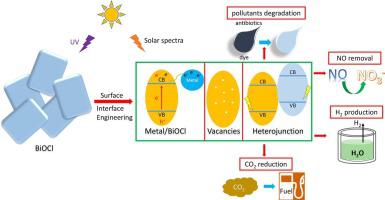当前位置:
X-MOL 学术
›
Adv. Colloid Interface Sci.
›
论文详情
Our official English website, www.x-mol.net, welcomes your feedback! (Note: you will need to create a separate account there.)
Surface and interface engineering of BiOCl nanomaterials and their photocatalytic applications
Advances in Colloid and Interface Science ( IF 15.6 ) Pub Date : 2024-01-14 , DOI: 10.1016/j.cis.2024.103088 Shijie Wang , Dongxue Song , Lijun Liao , Mingxia Li , Zhenzi Li , Wei Zhou
Advances in Colloid and Interface Science ( IF 15.6 ) Pub Date : 2024-01-14 , DOI: 10.1016/j.cis.2024.103088 Shijie Wang , Dongxue Song , Lijun Liao , Mingxia Li , Zhenzi Li , Wei Zhou

|
BiOCl materials have received much attention because of their unique optical and electrical properties. Still, their unsatisfactory catalytic performance has been troubling researchers, limiting the application of BiOCl-based photocatalysts. Therefore, many researchers have studied the adjustment of BiOCl-based materials to enhance photocatalytic efficiency. This review focuses on surface and interface engineering strategies for boosting the photocatalytic performance of BiOCl-based nanomaterials, including forming oxygen vacancy defects, constructing metal/BiOCl, and the fabrication of semiconductor/BiOCl nanocomposites. The photocatalytic applications of the above composites are also concluded in photodegradation of aqueous pollutants, photocatalytic NO removal, photo-induced H production, and CO reduction. Special emphasis has been given to the modification methods of BiOCl and photocatalytic mechanisms to provide a more detailed understanding for researchers in the fields of energy conversion and materials sciences.
中文翻译:

BiOCl纳米材料的表面与界面工程及其光催化应用
BiOCl材料因其独特的光学和电学性能而备受关注。尽管如此,它们令人不满意的催化性能一直困扰着研究人员,限制了 BiOCl 基光催化剂的应用。因此,许多研究人员研究了调整BiOCl基材料以提高光催化效率。本综述重点关注提高 BiOCl 基纳米材料光催化性能的表面和界面工程策略,包括形成氧空位缺陷、构建金属/BiOCl 以及半导体/BiOCl 纳米复合材料的制造。上述复合材料的光催化应用还包括水污染物的光降解、光催化NO去除、光诱导H产生和CO还原。特别强调了BiOCl的修饰方法和光催化机理,为能源转换和材料科学领域的研究人员提供更详细的了解。
更新日期:2024-01-14
中文翻译:

BiOCl纳米材料的表面与界面工程及其光催化应用
BiOCl材料因其独特的光学和电学性能而备受关注。尽管如此,它们令人不满意的催化性能一直困扰着研究人员,限制了 BiOCl 基光催化剂的应用。因此,许多研究人员研究了调整BiOCl基材料以提高光催化效率。本综述重点关注提高 BiOCl 基纳米材料光催化性能的表面和界面工程策略,包括形成氧空位缺陷、构建金属/BiOCl 以及半导体/BiOCl 纳米复合材料的制造。上述复合材料的光催化应用还包括水污染物的光降解、光催化NO去除、光诱导H产生和CO还原。特别强调了BiOCl的修饰方法和光催化机理,为能源转换和材料科学领域的研究人员提供更详细的了解。



























 京公网安备 11010802027423号
京公网安备 11010802027423号